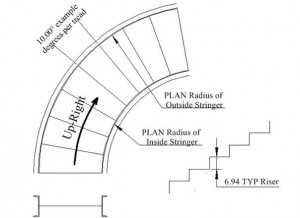My older son, Tyler, is a sophomore taking Geometry and just failed his trigonometry pop quiz on sine, cosine, and tangent. Panicked for his test the next day, we had a great teaching opportunity. He knew the rule soh-cah-toa (sine is opposite over hypotenuse…etc), but did not know how to apply the rule.
My kids know better than to ask the “when-will-I-ever-need-this” question anymore. They know that the pi button on my calculator is worn out and that I need the TI-30X calculator because it has the SIN,COS,TAN as individual buttons instead of just one single TRIG button. Our calculators store the last 50 commands that you give it, so I was able show him that I had used TRIG functions throughout that day. Anyway, after 20 minutes of practice, he got it down solid and aced the test.
So what do you need to ace the task of specifying stair stringers for circular staircases?
1. Always give the plan view radius. This is the radius looking straight down. Don’t try to figure the “sloped” or “roll” radius. If the plan view is multiple radius or elliptical, then give that detail in the plan view.
2. Pitch Degree / Slope of the Stringer (Along the tread face is preferred, but just specify where you are measuring it.) This is where the Trigonometry comes in. The slope of the stair is the inverse tangent of the rise divided by the run. On your calculator the inverse tangent is the ATAN or TAN-1 button. The rise is usually called out pretty clearly, but the run is a little trickier. Straight stair builders can specify just one pitch because the run is the same (the treads are the same width across). But with circular staircases, the run is different on either side; the tread width is smaller at the inside of the stair than the outside. Sometimes the easiest thing to give is the Degrees per tread in plan view of one tread. This one number will give both pitches.
3. Up-Right versus Up-left. When you walk up the circular staircase, are you turning to the right or left? Please don’t use clockwise or counter-clockwise because they are different depending on your perspective. Are you the bird looking down at the clock? Or the worm looking up?
4. Don’t forget to include the General Specifications for rolling such as material type: steel, aluminum, or stainless; orientation of the member: flanges- in, flanges out, etc; surface finish: is it critical or will it be covered with drywall.
Do this right and get an A!
Regarding the design and fabrication of circular stairs, please see the Chicago Metal Rolled Products easy-to-use and powerful Stringer Calculator. It’s likely to make your life easier by providing quick and accurate computations, improved communication, and increased quality.








